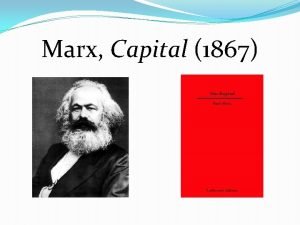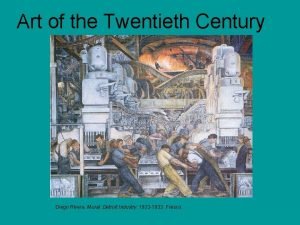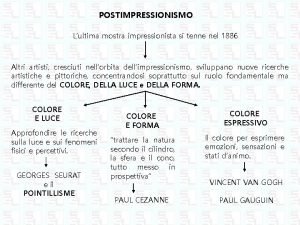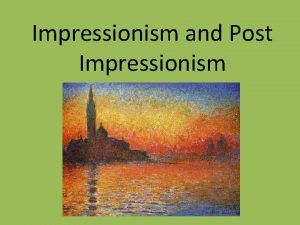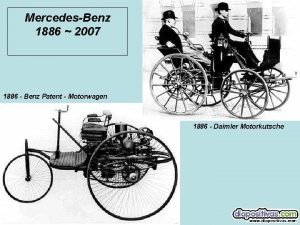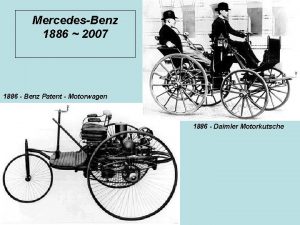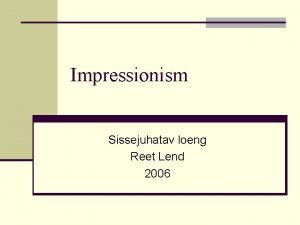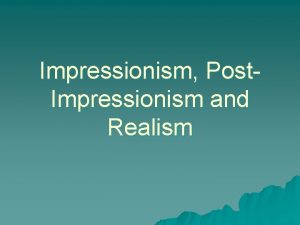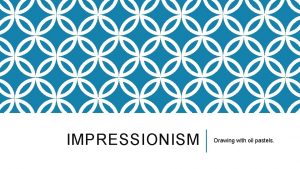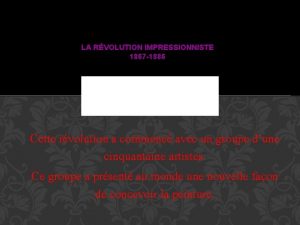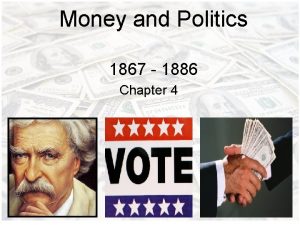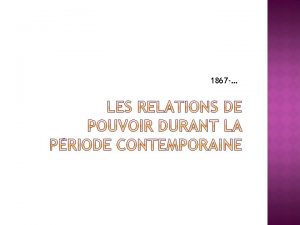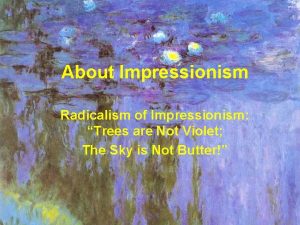IMPRESSIONISM 1867 1886 Impressionism Originated in France in























- Slides: 23

IMPRESSIONISM 1867 -1886

Impressionism Originated in France in 1870’s Invention of photography At first the public did not like their work. One newspaper critic called their work sketches or impressions, but not finished pieces. Thought it was a joke. Rejected by academy, public rebelled = creation of Salon of the Rejected Monet – Impression Sunrise

Style Characteristics Light was important to the Impressionists. They wanted to capture the moment. Scenes of daily leisurely activities (movement away from historical themes) Loose/small brushstrokes to simulate actual reflected light Pastel colours (with blues and violets replacing blacks and browns) Lack of a structured composition (as compared to a triangular Renaissance layout) Natural lighting Reproduced artists’ visual “impression” “Suggestion” rather than representation

Know your Artists… Edouard Manet Father of Impressionism – never stopped using black Claude Monet Most committed Impressionist painter, repeatedly painted objects over and over to observe how light affects colour Pierre-Auguste Renoir Rosy-cheeked people in social settings Edgar Degas Diagonal compositions, skilled at drawing, pastel, & painting, ballerinas Mary Cassatt America-born, known for women & children in natural domestic settings

Edouard Manet Father of Impressionism – never stopped using black

Edouard Manet, Luncheon on the Grass, 1862 -63 - Rejected by the academy modern France - Breaks classical rules life M. Raimondi, Judgment of Paris, c 1515. HIGH ITAL RENAISSANCE - problem = she’s not a Venus, confrontational, this is - assumption of sexuality in non-classical manner - sensual still

Compare Manet’s Olympia with Titian’s Venus of Urbino

Edouard Manet, Olympia, 1863 • • . Long Greek and Roman tradition to paint/sculpt nudes Challenges established ideas about what great art is Not a Venus (features not idealized and perfected) Not coy but confronting audience Prostitute Servant handing her flowers from a customer Flatness of body (“I’m not going to pretend that my painting isn’t paint”) Modern beauty for the real world

Edouard Manet, A Bar at the Folies-Bergère, 1882 • Night club in Paris for upper middle class • Reflection in mirror does not match up • Distance/vacancy in her eyes • Bored? Sulky? Sad? • Detachment from her surroundings • Manet’s final painting

Claude Monet Most committed Impressionist painter, repeatedly painted objects over and over to observe how light affects colour

Claude Monet – Water lilies Monet’s garden Harmonious colour Not traditional landscape – no horizon Rough application of paint, layers Colours are overlaid, not blended

Claude Monet – Water lilies and the Japanese Bridge Monet’s garden Solid colours Short brushstrokes Layering

Pierre-Auguste Renoir Famous for rosycheeked people in social settings

Moments in time Leisurely Use of light Loose brushwork

Middle/ upper class Moments in time candid

Edgar Degas Considered the master of drawing the human figure in motion Known for paintings of ballerinas § Very diagonal compositions § Figures tend to run-off sides § Strong but natural light sources

Edgar Degas, Ballet Rehearsal, 1876 • Frequent cut-off figures, objects, stairs = his interest in capturing single moments in time, like photography • Prominent diagonals of floorboards carry viewers eyes throughout painting

Edgar Degas, The Dance School, 1874

Edgar Degas, The Dancing Class, 1873 -75

Mary Cassatt America-born Known for women & children in natural domestic settings • • • Responsible for the care of her aging parents. Could not frequent the cafes and bars with her male artist friends Because of these restrictions, Cassatt’s subjects were principally women and children

Mary Cassatt, The Bath, 1892 • Tender relationship between a mother and child. • Visual solidity of the mother and child contrasts with the flattened patterning of the wallpaper and rug. • Moment in time

Contrast how Renoir and Cassatt view a mother and child

Mary Cassatt, Mother and Child, 1889
 Impressionism originated
Impressionism originated Symbolism vs impressionism
Symbolism vs impressionism 1934 - 1867
1934 - 1867 Donatello timeline
Donatello timeline Capital 1867
Capital 1867 Tenure of office act 1867
Tenure of office act 1867 Lister 1867
Lister 1867 4800 bc popcorn
4800 bc popcorn Devastación
Devastación Home rule 1886
Home rule 1886 1886 modern compound light microscope
1886 modern compound light microscope Msn 1886
Msn 1886 Tower bridge 1886
Tower bridge 1886 1886
1886 Hertz 1886
Hertz 1886 1886 modern compound light microscope
1886 modern compound light microscope Poeet 1890 1952
Poeet 1890 1952 Gauguin cristo giallo
Gauguin cristo giallo 1830-1886
1830-1886 This breed originated in french alps
This breed originated in french alps Where did medieval theatre originated
Where did medieval theatre originated Lagaylay originated from
Lagaylay originated from The modern mother's day celebration originated from
The modern mother's day celebration originated from The scandal known as watergate originated from the
The scandal known as watergate originated from the




